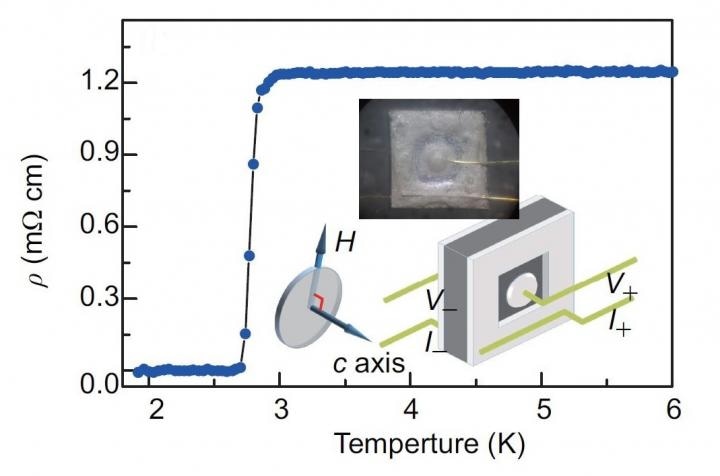Feb 14 2017
The study on topological superconductors (TSCs) is one of the hotspots in the field of condensed matter physics and has drawn great attention. Recently, Prof. Hai-Hu Wen's group from Nanjing University succeeds in detecting the two-fold symmetry of the superconductivity in SrxBi2Se3, which provides new evidence for the argument that SrxBi2Se3 is a TSC.
 Temperature dependence of resistivity of S1 at zero field. The insets show the photograph of S1 with the electrodes (above) and the Corbino-shape like electrode configuration (below). Credit: ©Science China Press
Temperature dependence of resistivity of S1 at zero field. The insets show the photograph of S1 with the electrodes (above) and the Corbino-shape like electrode configuration (below). Credit: ©Science China Press
The corresponding paper (Superconductivity with Two-Fold Symmetry in Topological Superconductor SrxBi2Se3) is published on Science China Physics, Mechanics & Astronomy. The researchers detected the c-axis resistivity measured on high-quality SrxBi2Se3 single crystals by using the Corbino-shaped electrode with the magnetic field rotating in the basal plane. With this configuration, the vortex contribution to resistivity is supposed to be the same for any angles and the intrinsic information of the superconductivity can be obtained.
Topological superconductors (TSCs) are novel quantum phases. The unconventional superconductivity in TSCs cannot be connected to a topological trivial phase adiabatically without closing the superconducting gap. As a consequence, a TSC is supposed to possess robust gapless excitations on the boundary or surface. Because of the particle-hole symmetry of superconducting states, the excitation at zero energy is composed of same weight of electrons and holes. Such a zero energy excitation satisfies the requirement of Majorana fermions whose antiparticle is identical to itself. The Majorana fermions in TSCs have various exotic phenomena and can help to realize topological quantum computation.
Doping induced superconductors from topological insulators are predicted to be topological superconductors by theorists. Prof. Ando's group studied these materials by point contact tunneling measurements and proved that the superconductivity of the materials was consistent with the expectation of TSC. However, some other groups drew an opposite conclusion by the scanning tunneling spectroscopy (STM) studies. This makes the issue under intensive debates.
This research performed the c-axis resistivity measurements with an angle-dependent in-plane magnetic field on four SrxBi2Se3 samples with the Corbino-shape like electrode configuration. Dramatic two-fold symmetry features were observed in all the angular dependent resistance measurements at low magnetic fields and temperatures. This is consistent with the earlier experiments by NMR and angle resolved magnetocaloric measurements. Prof. Fu modulated the theoretical calculation and stated that the two-fold symmetry indicated the nontrivial topological order of the superconductivity in SrxBi2Se3.
"This research provides the evidence of topological superconductivity in SrxBi2Se3," said the researchers, "and also widen and deepen our understanding of the topological superconductivity."